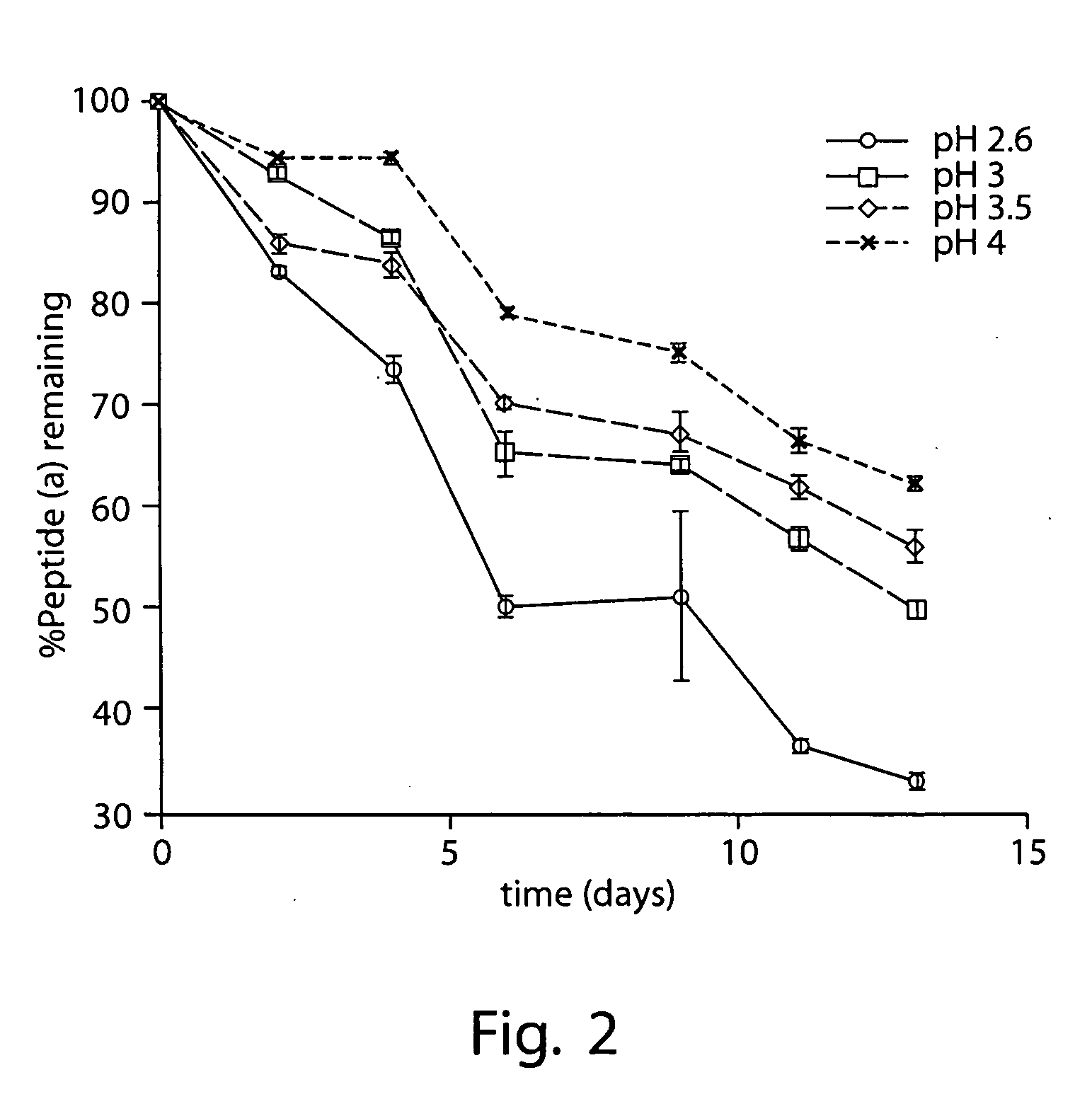Composition for enzyme inhibition
a technology of enzyme inhibition and composition, which is applied in the direction of depsipeptides, peptide/protein ingredients, macromolecular non-active ingredients, etc., can solve the problem of difficult formulation of compositions with optimal bioavailability, and achieve the effect of solubility of proteasome inhibitors
- Summary
- Abstract
- Description
- Claims
- Application Information
AI Technical Summary
Benefits of technology
Problems solved by technology
Method used
Image
Examples
example 1
Peptide (b) / HPBCD Formulation
[0374] 100 μg / mL peptide (b) was formulated in an aqueous solution containing 130 mg / mL hydroxypropyl beta cyclodextrin (HPBCD) and ca. 0.9% (w / v) NaCl. This was a supersaturated (metastable) solution at room temperature and could not be made by simply dissolving peptide (b) in aqueous 13% HPBCD / 0.9% (w / v) NaCl.
[0375] The desired quantity of peptide (b) was weighed and dissolved in absolute ethanol at a concentration of 1 mg / mL. For each 1 mg of peptide (b) to be formulated, 1.3 g HPBCD was dissolved in absolute ethanol at a concentration of 10 mg / mL. This ethanol / HPBCD solution was then combined with the ethanol / peptide (b) solution, stirred 5 minutes at room temperature and then evaporated under reduced pressure (rotovapped) to yield a white solid. This solid was placed under high vacuum (ca. 1 mTorr) for 24 hrs, pulverized and then placed under high vacuum (ca. 1 mTorr) for another 4 hrs to yield dry solid. The final formulation was prepared by diss...
example 2
Peptide (a) / SBECD Formulation
[0376] 2 mg / mL peptide (a) was formulated in an aqueous solution containing 10% (w / v) SBECD and 10 mM citric acid adjusted to pH 3.5 with 0.1 M aqueous sodium hydroxide.
[0377] Appropriate masses of SBECD and citric acid were added to a volume of WFI corresponding to approximately 75% that of the final formulation. This mixture was then stirred at room temperature until complete dissolution of the SBECD and citric acid was effected. An appropriate mass of peptide (a) was then added and the resulting mixture stirred at room temperature until the added peptide (a) was dissolved. A pH electrode was then immersed in the solution and, with rapid stirring, the pH was adjusted to 3.5 by slow addition of 0.1 M sodium hydroxide in WFI; slow addition of the sodium hydroxide solution with adequate stirring was necessary to prevent precipitation of peptide (a). With rapid stirring, the resulting solution was then diluted with WFI to a final peptide (a) concentratio...
example 3
(3×) Peptide (a) / SBECD Formulation, Lyophilization of Formulation and Reconstitution.
[0380] 6 mg / mL peptide (a) was formulated in an aqueous solution containing 30% (w / v) SBECD and 30 mM citric acid adjusted to pH 3.5 with 0.5 M aqueous sodium hydroxide.
[0381] Appropriate masses of SBECD and citric acid were added to a volume of WFI corresponding to 70% that of the final formulation. This mixture was then stirred at room temperature until complete dissolution of the SBECD and citric acid was effected. An appropriate mass of peptide (a) was then added and the resulting mixture stirred at room temperature until the added peptide (a) was dissolved. A pH electrode was then immersed in the solution and, with rapid stirring, the pH was adjusted to 3.5 by slow addition of 0.5 M sodium hydroxide in WFI; slow addition of the sodium hydroxide solution with adequate stirring was necessary to prevent precipitation of peptide (a). With rapid stirring, the resulting solution was then diluted wi...
PUM
| Property | Measurement | Unit |
|---|---|---|
| Fraction | aaaaa | aaaaa |
| Concentration | aaaaa | aaaaa |
| Concentration | aaaaa | aaaaa |
Abstract
Description
Claims
Application Information
 Login to View More
Login to View More - R&D
- Intellectual Property
- Life Sciences
- Materials
- Tech Scout
- Unparalleled Data Quality
- Higher Quality Content
- 60% Fewer Hallucinations
Browse by: Latest US Patents, China's latest patents, Technical Efficacy Thesaurus, Application Domain, Technology Topic, Popular Technical Reports.
© 2025 PatSnap. All rights reserved.Legal|Privacy policy|Modern Slavery Act Transparency Statement|Sitemap|About US| Contact US: help@patsnap.com



